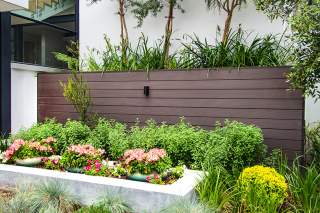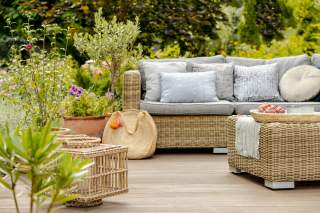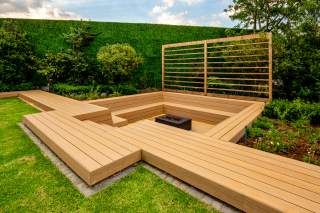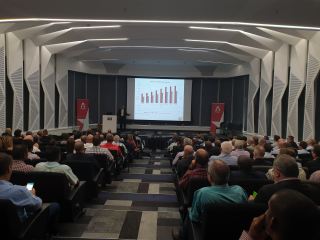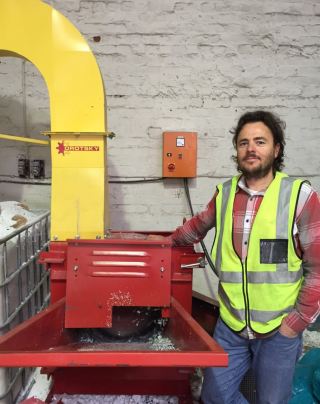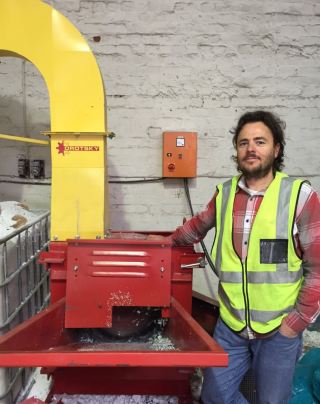how to make living spaces truly come alive
There are many definitions of ‘green’ as it pertains to buildings, but the latest sustainable lifestyle trend toward living walls and living roofs has the ultimate credentials in low-impact living. Rather than being quite literally a statement façade, there are sound reasons for bringing plants into our architectural designs.
Living walls and roofs – otherwise known as green walls and roofs or even ecowalls and ecoroofs – can be either free-standing or attached to wall and roof surfaces, in horizontal or vertical designs and can be planted in soil or use hydroponic systems to provide drip irrigation to the plants selected for the design.
Green walls are typically built using a suitable skeletal structure of supports and watering grid to keep the plants healthy. Choosing the types of plants to hang on green walls is much like choosing a paint colour – only with much more variation possible. The benefits of bringing green walls into living spaces are manifold – from cleaning the air we breathe to reducing ambient noise that would ordinarily bounce off of hard walls, to providing an aesthetically pleasing natural environment.
The temperature fluctuation control, insulation and UV light reflection properties of green roofs are where nature really comes into its own – reducing household energy requirements for climate control in the process. The collective benefit of green roofs in an urban area is the reduction of what is called the ‘heat island effect’ that occurs in cities, where a typical lack of vegetation causes urban areas to be considerably hotter than naturally green areas.
For buildings with suitable rooftops, green roof designs can provide even more benefits, from vegetable planter boxes to natural climate control and a beautiful private recreation space that increases a home’s traditional living area. Adding green walls and green roofs is one way to eliminate ‘sick building syndrome’, which can be summed up as that dreary feeling of living in an artificial environment that is both boring and adds nothing to our health and enjoyment of living. This is especially the case where green walls can be added to office and workspaces.
“Even adding plant boxes, trellises and green trims to a living space can make a considerable difference to one’s quality of life. Not every house is perfectly suited to installing a fully green roof, but we are certainly seeing how property owners are becoming creative with using building materials to bring nature closer to the home,” says the CEO and co-founder of building materials group Eva-Last, Marc Minne.
“Sustainable living elements in homes are now fetching a premium on the market because of the range of features they provide, from energy cost reductions to aesthetic beauty and health benefits. We are pleased to see so many people using Eva-Last’s environmentally sustainable products to form the frameworks for green installations,” he adds.
Eva-Last’s composite building products combine the fast-growing and easily replenished fibres from bamboo with recycled plastic and aluminium materials to provide light, structurally strong and durable building products such as cladding, decking and architectural beams, which are synergistic in designing and creating a green living environment.
“Sustainable elements are changing the face of the urban landscape by providing both new and retrofitted green elements that bring the natural functions of vegetation into our living and social areas. This trend is long overdue, given the benefits greenery has for improving quality of life, decreasing stress and smoothing the flow between natural and built areas to make sure that our cities are sustainable,” says Minne.
The Art of Landscaping
Lockdown restrictions and reluctance of the public to gather in confined spaces have led to some significant changes in the way we work, live and play. One notable trend, that is aligned with the work-from-home ethos over the last 18 months, is landscaping; where entertaining at home has pushed designs toward functionality.
Glenice Ebedes, author of the Gardener’s Guide to Indigenous Garden Plants of Southern Africa and the owner of Grounded Landscaping, says with people spending more time at home, requests for picture gardens have all but disappeared. Instead, customers want living spaces incorporating features for entertainment such as seating and fire pits.
In many ways, the pandemic served to accelerate the incorporation of certain materials and products in the same way that it ushered consumers toward digital channels. As the world increasingly considers sustainability above everything else, the availability and usage of water-wise and low-maintenance plants and materials has gained momentum.
“The most common requests now are for indigenous and water-wise gardens. Also, where it used to be a case of simply putting plants into the garden, people are now considering much more carefully how their gardens will be used,” says Ebedes.
“On the building materials front, there is certainly a much wider range of materials available than there was a decade ago. Just like with the plants they are requesting, people are seeking sustainability and durability of products put into their living spaces,” she adds.
While some people are resolute about the use of real timber in their gardens, there are pros and cons to any approach and landscapers must now present a wider variety of choices to customers than ever before. “The whole look and feel of what can work in a garden is changing,” says Ebedes.
There are certainly more ways to use building materials in the modern context. As older suburbs with large yards and swimming pools give way to smaller, denser living arrangements in secure estates or complexes, Ebedes says screening is a common request. “Now that people are living much closer to each other and being forced to entertain at home more, due to Covid-19, privacy is a big driver behind most garden designs,” she says.
Marc Minne, CEO and co-founder of building materials company Eva-Last, says this is consistent with what suppliers have seen in the market. “This is a very exciting time to be providing composite building materials that are pushing technical boundaries. Traditional materials like timber have remained fairly stagnant in their application and required maintenance, where the incorporation of composite materials has really broadened the uses for building materials. Advancements in finishes, structural performance and reduced weight of composite materials has seen landscaping designs explode with possibilities,” says Minne.
“Where landscapers used to be restrained by the capabilities of materials, it is now possible to be genuinely creative in establishing a flow and aesthetic from indoors to outdoors to create the ultimate continuous living space for home entertainment comfort. The homeowner also benefits from the low maintenance requirements of composite materials, and therefore can spend more time enjoying their outdoor living spaces rather than maintaining them,” he adds.
Dewald van Zyl, project administrator for Living Green Landscapes, says a few years ago most landscaping requests were for themed gardens, such as English, Balinese or Japanese. “This has changed significantly and quickly to requests for water-wise, low-maintenance gardens with plants that are easier to come by. The underlying change behind this trend is the Covid-19 effect. Where customers would arrange for landscaping but seldom even be at the premises while we were busy, they are now taking much closer interest in their gardens,” he says.
“About 90% of the time we are asked to install bomas and entertainment areas now, while we used to get asked for decorative landscaping. It shows a trend toward functional and constructive landscaping – we're asked to integrate the garden into the entertainment features rather than the other way around. No more lawns and flower gardens.”
In terms of sustainability, Van Zyl says most garden designs are cost-driven. “Though the water-wise and indigenous trend is clear, this is often because of the shift toward eco-estate living, where residents need to align with estate landscaping policies. This comes with the benefits of low maintenance and costs.”
Although he is often asked to incorporate herb gardens, raised beds or container gardens into designs, this does not mean customers are suddenly farming at home, Van Zyl adds. “It may be an upcoming trend, but generally these gardens are being designed with entertainment in mind, rather than the hard work it takes to maintain a productive permaculture garden.”
Fire Up Your Outdoor Inspiration
Fire pits come in many traditional designs and materials but they all serve the same purpose – to provide aesthetic viewing pleasure and functional warmth to any outdoor entertainment area. Whether winter or summer, an outdoor fire pit puts everyone in a relaxed and comfortable frame of mind.
The evolution of modern building materials has created virtually endless possibilities when it comes to the seamless integration of fire pits into outdoor landscaping. A fire pit is no longer simply a functional hole in a cemented area or an iron brazier in the backyard.
These days a homeowner can literally flick a switch and turn on a gas-burning fire pit that is the focal point of an outdoor entertainment area that is safe, comfortable and highly customised.
Nathan Chapman, founder of building materials group Eva-Last, says fire pits and timber finishes used to be incompatible – but no more, thanks to advancements in composite decking and cladding technology.
“A garden, terrace or veranda can be transformed by taking advantage of the aesthetic beauty of natural timber finishes while being completely safe and suffering from none of the inherent drawbacks of real timber. Composite decking materials are ideal for landscaping outdoor living spaces to create comfortable, stylish and functional areas that will not deteriorate due to even the harshest environmental conditions,” he says.
While natural timber struggles to maintain its original finish and structural performance when subjected to weathering, composite materials such as Eva-Last’s Apex range of profiles perform and look for decades like they did on day one. It also means design elements used indoors can flow seamlessly to outdoor entertainment spaces with no worry about degradation of the appearance of the same materials used externally. This has opened up a whole new world of architectural design to include landscaping elements.
“A range like Apex represents the ultimate in lightweight composites with market-leading span performance and an appearance that is indistinguishable from that of natural timber. Apex eliminates all the secondary issues that makes timber unsuitable as an outdoor landscaping material, such as moisture retention, pedestrian slippage risk, surface damage, warping, splitting and burning,” says Chapman.
Designed for use in decking, cladding, fencing, screening and railing, Apex is purpose-designed to outperform all other materials in all weather conditions and comes with an incredible 30-year guarantee.
“That is three decades of guaranteed performance with almost no maintenance required in its functional life, aside from the occasional clean. An equally important consideration is Apex’s Bfl S1 fire resistance rating, which makes it ideal for use in both residential and commercial settings,” adds Chapman.
An appreciation of outdoor living goes hand in hand with environmental consciousness and Eva-Last’s composite decking and cladding materials are all manufactured using solar energy and using recycled plastics. “This is increasingly becoming an important consideration for homeowners who want the aesthetic appeal of natural timber without worrying about its provenance or impact on the environment,” he says.
AfriSam 2019 Budget Speech
The construction and infrastructure industry should expect another tough year during 2019 following reduced budget allocation to the sector by the minister of Finance Tito Mboweni, this according to South Africa’s leading economists speaking at the Annual AfriSam Post-Budget Breakfast event. Political analyst Aubrey Matshiqi adds that national elections on 08 May will add to business pressures, despite that the African National Congress (ANC) being expected to retain its majority position in parliament.
South Africa’s construction materials giant hosted an insightful post-budget breakfast session with Dr. Azar Jammine director and chief economist at Econometrix, David Metelerkamp, Senior Economist at Industry Insight and political analyst Aubrey Matshiqi.
“2019 is going to be tough for the local economy, but better than 2018. There were positive signs in the budget. There are still some risks especially around the function of the SOEs, slow-down in the global economy because of the trade wars between the US and China, as well as Brexit. On the local front the power supply challenges at Eskom is South Africa’s biggest quandary,” says Dr. Jammine.
On infrastructure, Dr Jammine says the budget showed very little of President Cyril Ramaphosa’s pronouncement to increases infrastructure spend. “The numbers presented don’t show increased spend on infrastructure even though we are hearing the President and minister of finance talk of infrastructure”. He adds that in nominal terms, budget allocation for infrastructure rose by about 4%.
Metelerkamp highlighted the reduction of infrastructure spend from 2017 to 2019. State-Owned Enterprises (SOE’s) are the biggest contributors to poor infrastructure spend in the economy, resulting in the construction industry being at recessionary levels. “The year 2018 was not a good year for construction as there was a 15% decline in the nominal value of construction projects awarded”, said Metelerkamp.
He adds that if the R864,9bn allocated to construction and infrastructure is spent effectively, it could be a step in the right direction for the economy and job creation. In addition, a positive cleanup of the SOEs (restructuring Eskom being a step in the right direction), implementation of renewable energy projects, road upgrades, and the building of affordable housing could restart the economy.
Matshiqi said South Africa could be facing another recession and downgrade by credit rating agencies if steps are not taken to change current economic course, boost foreign investors’ confidence, and dealing with corruption and some of the negative sentiment emerging from the various commissions of inquiry. “Change will only come with the decisions we take as individuals”, encouraged Matshiqi.
AfriSam Sales & Marketing Executive, Richard Tomes said the construction market was facing serious headwinds, some of which could be resolved if the state-owned entities are fixed and made to function efficiently, especially Eskom.
This second Annual AfriSam Post-Budget Breakfast event brought together more than 200 infrastructure, materials and construction specialists to review the impact of the national budget on the sector.
-- END --
This article was published by Archy Hlahla, Hlengani Communications on behalf of AfriSam.
Hoxana Consulting Engineers changing lives for the better living conditions for Wesselton residents
The growing number of informal settlements in South Africa is increasing pressure on basic services that the government has to provide such as water and sanitation, housing and electricity, challenges both local and national government are working extremely hard to address. Hoxana Consulting Engineers has partnered with various local municipalities to deliver service of the highest quality as part of government’s commitment to eradicate dire conditions in disadvantaged communities such as Wesselton, Ermelo.
The Wesselton settlement consists of both formal and informal settlements which have developed as a result of the housing shortages in the area. Wesselton Extension 5 currently has 100 informal structures housing 400 people, and extension 10 has a total of 51 informal living structures which are home to 212 residents.“These informal settlements are a health hazard and a resolution to formalize all informal settlements has been made by Msukaligwa Local Municipality (MLM)”, says Livingstone Mashele, Managing Director at Hoxana Consulting Engineers.
The Msukaligwa Local Municipality appointed Hoxana Consulting Engineers to undertake the planning, design and construction monitoring for the implementation of the extension of sewer reticulation from Wesselton Extension 5 and 10. The estimated cost of the proposed sewer reticulation and toilets for Wesselton Ext 5 is valued at R 2 390 429.98 and R 1 703 250.52 for Wesselton Ext 10.The completion of the sewer reticulation will greatly improve the quality of life for all residents through hygienic living conditions, reduction in pollution and eradication of water borne diseases such as Cholera and Typhoid.
Hoxana Consulting Engineers will also ensure that local communities benefit from the project through the adoption of labour intensive construction methods and training. “At Hoxana, we strongly believe in community upliftment which is why approximately 60% of this project will be executed through labour Intensive process in order to empower the local labourers and to provide technical skills to the local community”, says Mashele.The Wesselton project began 29 January 2018 and should be completed and handed over to the local community on at the end of June 2018.
15 Tonnes of recycled polystyrene used in construction of new Table Bay Mall
More than 15 tons of recycled, Expanded Polystyrene (EPS) have already gone into the production of 20,000 Greenlite Concrete blocks used in the new Table Bay Mall that is currently being constructed. Expected to open its doors at the end of September this year, this 65 000 m² regional shopping centre is located on a 20 ha site on the corner of the R27 (West Coast Road) and Berkshire Boulevard in the heart of the rapidly growing West Coast area.
Vivid Architects / Group Five Construction contractors are at the helm of the project, and specified Greenlight Concrete blocks for use primarily on the fire escape passages owing to the product’s excellent fire rating.
“With climate change looming and the rising cost of energy, building contractors are looking at sustainable building options. Over the past 18 years, we have been involved in the manufacturing and installing of Alternative Building Technologies. We were looking for a more environmentally friendly way of implementing our insulated building systems, when we started experimenting with recycled polystyrene as the basis for our energy efficient walling systems,” explains Hilton Cowie, Technical Director of Greenlite.
Greenlite’s Insulated Concrete is the culmination of more than 18 years’ of experience and research, the blocks consist of recycled polystyrene which is used as a lightweight aggregate mixed with cement and additives to form insulated, soundproof, fireproof, water-resistant lightweight concrete blocks and screeds that have already been used in various large, commercial projects such as the Trumpet Towers in Johannesburg, the BMW Pavilion and Zeits Museum in the V&A Waterfront, Baywest Mall in Port Elizabeth and the Gautrain Station in Sandton.
“The developers were amazed at how quick and easy it was for them to build the walls using Greenlite blocks. Because these blocks are lightweight, they are easy to move around the site and the engineers saved weight loading onto the suspended concrete slabs,” Cowie says.
These blocks are proving invaluable to the construction industry where clients and contractors are able to reduce their structural concrete and steel requirements due to the lightweight nature of the walls. The highly insulated walls also offer the added benefit of further energy savings to the client over the lifespan of the building. Greenlite Concrete accepts any form of polystyrene for recycling on their premises, and is willing to assist in arranging collection of large quantities of Polystyrene.
"We recycle and use the polystyrene faster than we can get our hands on it. Builders Warehouse are now also exclusive stockists of our various sized Jumbo blocks and screeds, creating an even greater demand for polystyrene that we can use,” Cowie explains.
“We are very excited about the growing popularity and rapid market acceptance of this new building technology. Not only does it have a direct and positive impact on our recycling rates by diverting large volumes of post-consumer polystyrene from our country’s landfills, but it also helps to create more employment opportunities, reduce building costs and increases productivity. We are hoping to improve on our 2016 record of 2 036 tons of polystyrene that were successfully recycled through our Project Build,” concludes Adri Spangenberg, Director of the Polystyrene Packaging Council.
For more information, visit www.polystyrenepackaging.co.za or www.greenliteconcrete.co.za
Polystyrene recycling in SA continues to exceed expectations
Polystyrene recycling in South Africa has continued to grow in 2016, contrary to international reports that labelled this versatile product as “challenging to recycle” and sometimes even as being unrecyclable.
According to Polystyrene Packaging Council Director, Adri Spangenberg, the reprocessing of expanded and high impact polystyrene has increased by 106 % between the period 2013 and 2015 in South Africa owing to the fact that more end-markets were developed and knowledge of the fact that the material can successfully be reused in various different applications, continued to grow.
“We are still awaiting the official recycling figures for 2016, but early indications show that approximately 3 600 tons of recycled polystyrene were added to the traditional recycling figures – making this our best year to date,” Adri says.
“We have managed to prove that polystyrene can successfully be recovered from households and industries by working closely with waste management companies and municipalities. Moreover, our recycling projects are undoubtedly successful and yet another proof that South Africa is a truly unique country. We may be small, but we have our own way of doing things and have an ability to find solutions to problems that the rest of the world might find insurmountable,” she says.
Polystyrene is widely being used by spaza shops, take-away vendors, cafeterias and supermarkets around the country due to the fact that it insulates food and beverages, protects food and contents, is cost-effective, lightweight and convenient. Although it is a single-use plastic item, it gets recycled into items that continue to improve lives and create jobs in a variety of different industries, ranging from building and construction, to picture frames, cornices and home décor, clothing hangers and stationery.
“Last year alone, 2 036 tons of polystyrene were successfully recycled for use in lightweight concrete through our Project Build,” Spangeberg says. Hilton Cowie of Greenlite Concrete (http://greenliteconcrete.co.za) in Cape Town and Hennie Snyman of the Get Connected Group in Gauteng were the two biggest projects the PSPC currently supports, and uses recycled, post-consumer polystyrene for large commercial and residential construction projects around the country.
“We needed to have hammermills installed at both these premises last year in order to assist with the processing of the large volumes of polystyrene that are required for their construction projects. These mills are capable of pelletizing 150 kg of expanded polystyrene per hour in order to keep up with the demand,” she explains.
Another area that has seen impressive growth in the amount of recycled polystyrene it used, was the home décor market. More than 1 377 tons of expanded and high impact polystyrene were recycled last year for use in picture frames, cornices and curtain rods through the PSPC’s Project Dècor.
“Apart from the fact that it helped divert polystyrene from landfill, we are particularly pleased that this is another market where jobs and products were manufactured locally as opposed to relying on cheap imports from the Far East that have a detrimental impact on our own markets,” Spangenberg adds.
Looking ahead at 2017, the PSPC will continue to promote the use and the recycling of polystyrene to South Africans of all walks of life. “The Davos World Economic Forum gathering released their report last week in which they called for strategies to dramatically increase recycling of plastic packaging — from the current 14 % to 70 %.
So, whether you are an avid gardener who gets your plants from seedling trays, a business person getting your morning coffee from the work’s canteen or a miner enjoying your afternoon lunch from the cafeteria, the polystyrene you use should be recycled. Plastic is worth much more than its original purpose when used in infrastructure applications. For this reason, we believe that polystyrene should be re-used and recycled into building projects that will benefit many generations to come. Our polystyrene recycling projects not only touch lives and improve communities, but are also key to reclaiming useful carbons and a valuable resource that would otherwise have been lost. Polystyrene recycling helps to create jobs, opportunities and innovative new products in a true, circular economy model,” Spangenberg concludes.

